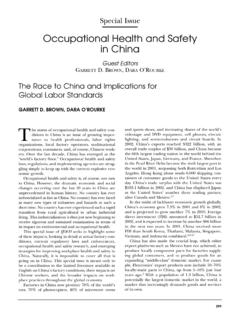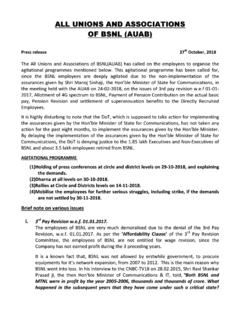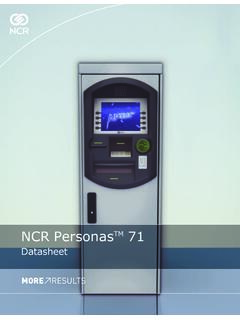Transcription of Idiopathic Sudden Sensorineural Hearing Loss - otosurgery.org
1 The n e w e ng l a n d j o u r na l of m e dic i n e clinical practice Idiopathic Sudden Sensorineural Hearing loss Steven D. Rauch, This Journal feature begins with a case vignette highlighting a common clinical problem. Evidence supporting various strategies is then presented, followed by a review of formal guidelines, when they exist. The article ends with the author's clinical recommendations. A healthy 58-year-old woman answers the telephone and realizes that her Hearing is diminished on the left side. She notices aural fullness and loud tinnitus in the affected ear. Later that day she has several hours of mild vertigo that clears by the following morning. Over the next few days, repeated self-administered ear cleaning with the use of an over-the-counter kit does not relieve the symptoms. How should she be eval- uated and treated?
2 The Cl inic a l Probl em Idiopathic Sudden Sensorineural Hearing loss ( , unexplained unilateral sensorineu- From the Department of Otology and Lar- ral Hearing loss with onset over a period of less than 72 hours) has an estimated in- yngology, Harvard Medical School, Bos- ton. Address reprint requests to Dr. Rauch cidence between 5 and 20 per 100,000 persons per This is likely to be an under- at Massachusetts Eye and Ear Infirmary, estimate, since many who recover quickly never seek medical Several large 243 Charles St., Boston, MA 02114, or at case series, including a total of approximately 7500 cases in the United States, Eu- rope, and Japan,1,3-11 indicate that Sudden Sensorineural Hearing loss typically oc- N Engl J Med 2008;359:833-40. curs between 43 years and 53 years of age, with equal sex distribution. Vestibular Copyright 2008 Massachusetts Medical Society.
3 Symptoms are present in 28 to 57% of patients. The likelihood of recovery of Hearing has been reported to vary with the severity of Hearing loss at presentation: patients with mild losses usually achieve full recov- ery, those with moderate losses often show some spontaneous recovery but seldom have a full recovery unless treated, and those with severe-to-profound Hearing losses rarely show spontaneous improvement or make a full ,4,12 The prognosis for recovery of Hearing also seems to be worse in older patients and those with as- sociated vestibular ,3-5. Approximately 1% of cases of Sudden Sensorineural Hearing loss are due to retro- cochlear disorders that may be related to vestibular schwannoma, demyelinating disease, or Another 10 to 15% are due to another identifiable cause, such as Meniere's disease, trauma, autoimmune disease, syphilis, Lyme disease, or perilym- phatic ,5,13,14 The remainder are Idiopathic and almost exclusively unilateral.
4 Rare cases of bilateral Sudden deafness most often reflect a psychiatric ( functional ). cause or a neurologic process ( , neoplastic dural infiltration of the posterior cranial fossa, paraneoplastic syndrome, or encephalitis); transient bilateral Sudden Sensorineural Hearing loss may also result from a Sudden drop in intracranial pres- sure during a spinal tap or after intracranial surgery. A common problem in Sudden Sensorineural Hearing loss is delay in diagnosis. Ear fullness, a common presenting symptom, is often attributed by patients and clinicians to impaction of cerumen or congestion from upper respiratory illness or allergies. Insofar as evidence suggests that permanent Hearing loss is more likely when treat- ment is delayed, it is important that a diagnosis of Sudden Sensorineural Hearing loss n engl j med 359;8 august 21, 2008 833.
5 Downloaded from at HARVARD UNIVERSITY on October 12, 2008 . Copyright 2008 Massachusetts Medical Society. All rights reserved. The n e w e ng l a n d j o u r na l of m e dic i n e Screening for Hearing loss can be performed by telephone ( , by a clinic nurse). The patient Patient reports unilateral ear blockage . new onset, developing over a period of <72 hr should be explicitly asked whether the Hearing is reduced. The patient can move the phone from ear to ear or crinkle a few hairs next to the ear on each No emergency may side to check for Hearing asymmetry. To assess Hearing loss No be muscle tension whether an apparent Hearing asymmetry is likely in neck or jaw or con- gestion, for example to indicate Sensorineural Hearing loss , the patient Yes should be instructed to hum and to report wheth- er the sound is louder in one ear than in the other.
6 Sound Probably conductive In conductive Hearing loss , sound lateralizes to the lateralizes Hum test to bad . Hearing loss not blocked ear, whereas in Sensorineural loss , sound an emergency ear lateralizes to the good ear. Sound lateralizes to good ear Office evaluation of Hearing can be done by softly whispering simple words or numbers in Probable SNHL a true otologic each ear and asking the patient to repeat them emergency aloud. Inspection of the ear canals and tympanic membranes with the use of a pneumatic bulb to assess drum mobility (to rule out middle-ear effu- Audiometric confirmation of new False alarm reassure sion) is essential. If cerumen cannot be adequately No patient SNHL removed to visualize the tympanic membrane, then otolaryngology consultation is indicated. The Yes Weber and Rinne tests should be performed using a 512-Hz tuning fork (Fig.)
7 2). A focused neuro- MRI with logic examination should assess for evidence of Start prednisone blast and taper Normal gadolinium to rule central or vestibular system dysfunction. Espe- out retrocochlear lesion cially relevant are assessments of ocular motility and sinusoidal gaze tracking by having the patient Abnormal keep the gaze fixed on a target as the head is pas- Repeat audiometry in follow-up Neurology or neurosurgery sively rotated side to side and up and down (sec- consultation ond, third, fourth, and sixth cranial nerves, brain stem, and cerebellum); facial sensation for light Figure 1. Management of Sudden Sensorineural Hearing loss (SNHL). touch and pinprick (fifth cranial nerve); voluntary and mimetic facial expression (seventh cranial ICM. AUTHOR: Rauch RETAKE 1st nerve); presence of spontaneous, gaze-evoked, or REG FbeFIGURE: considered 1 of 3 and prompt referral made to phy- 2nd 3rd positional nystagmus (eighth cranial nerve, cere- CASE sicians with expertise in otolaryngology.
8 Revised bellum, and brain stem); extremity coordination Line 4-C. EMail ARTIST: ts SIZE and rapid alternating movements (cerebellum); and H/T H/T 22p3. Enon S t r ategie Combos a nd E v idence postural and gait stability during the Romberg AUTHOR, PLEASE NOTE: test and tandem gait. Figure has been redrawn and type has been reset. Diagnosis Please check carefully. Sudden Sensorineural Hearing loss is often accom- Audiometry panied by intense aural fullness JOB: 35908 ISSUE:or08-21-08. pressure, as well A complete audiogram, including threshold mea- as tinnitus. If the patient has partial Hearing in the surements of bone- and air-conducted pure tones affected ear, the sound may seem harsh and dis- and speech audiometry, is needed for definitive torted (as if from a blown loudspeaker). Because diagnosis in patients in whom Hearing loss or aural fullness is nonspecific and often has nono- asymmetry is suspected.
9 Hearing threshold and tologic causes ( , temporomandibular joint dys- speech audiometry assess the loudness and the function or upper-airway congestion), the first step clarity of Hearing , respectively (Fig. 3). In sen- in diagnosis is to determine whether symptoms sorineural Hearing loss , the sensitivity to sounds are caused by Hearing loss (Fig. 1). delivered as bone-conducted stimuli and the sen- 834 n engl j med 359;8 august 21, 2008. Downloaded from at HARVARD UNIVERSITY on October 12, 2008 . Copyright 2008 Massachusetts Medical Society. All rights reserved. clinical pr actice . Tuning fork applied Loudness is compared when the tuning fork to midline forehead is placed near the external auditory canal and then pressed firmly against the skull behind the posterosuperior margin of the pinna. The patient is asked whether it sounds louder at the external meatus or on the skull.
10 In normal ears and ears with Sensorineural loss , the air-conducted sound at the meatus is louder than the bone- conducted sound. In . conductive Hearing loss ( 25-dB air bone Sound lateralizing Sound lateralizing gap), the bone-conducted sound will seem here suggests a here suggests a louder than the air-conducted sound. Sensorineural Hearing conductive Hearing loss on the bad loss on this side side Tuning fork pressed behind posterosuperior margin of pinna Tuning fork held near external auditory canal . Figure 2. Weber and Rinne Tests. The Weber test is conducted by ringing a 512-Hz tuning fork, placing it firmly on the middle of the forehead, and asking the patient where the tones are heard best: left, right, or center. If the Hearing is symmetric, the tone is cen- tered. The Rinne test is performed by comparing air conduction to bone conduction on each side.







